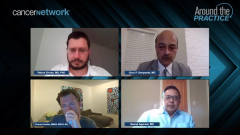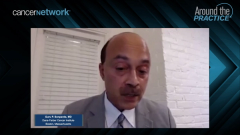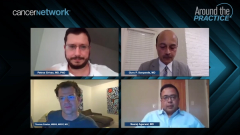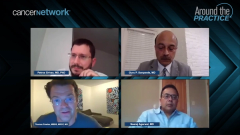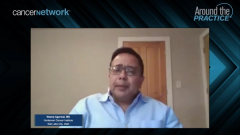
Standard of Care for First-Line Advanced Urothelial Cancer
Petros Grivas, MD, PhD; Guru P. Sonpavde, MD; Thomas Powles, MBBS, MRCP, MD; and Neeraj Agarwal, MD, share their approach to frontline therapy for patients with advanced urothelial carcinoma and consider the impact of cisplatin eligibility.
Episodes in this series

Petros Grivas, MD, PhD: Speaking about the treatment options for our patients, I’d like to turn to Tom. You’ve been a major contributor to the field advances for many years, and you’re also part of the ESMO [European Society for Medical Oncology] Clinical Practice Guidelines. Can you give us some comments? Also, we have NCCN [National Comprehensive Cancer Network] Guidelines in the United States with the start of care therapies in the first-line setting of advanced urothelial cancer. Can you drive us through this landscape: chemotherapy, cisplatin fitness, carboplatin use, and checkpoint inhibition?
Thomas Powles, MBBS, MRCP, MD: I’ll do it relatively quickly, and I hope I don’t oversimplify. The first question is whether the patient is fit for chemotherapy. Let’s make the assumption that they are. I feel that a vast majority of patients are fit for first-line chemotherapy, or IC [induction chemotherapy]—I would say as high as 90%, perhaps 80%—certainly the vast majority, in my opinion. The first question that 1 needs to ask is around cisplatin eligibility. The reason why that question is relevant is cisplatin-based regimes have level 1A evidence. There’s a perception that cisplatin is significantly more active than carboplatin in urothelial cancer, although actually the data to support that are driven by relatively small trials. Nevertheless, gemcitabine and cisplatin are considered to be the gold standard treatment for those patients who are eligible for cisplatin.
There are a series of criteria called the Matthew Galsky criteria, after his work with his team in this area. That’s basically a creatinine clearance of above 60 mL/min, although there’s debate about whether it’s between 50 and 60 mL/min, and I’m not sure we’ve got the time for that today; performance status; and other issues around neuropathy and hearing loss. Platinum eligibility is question No. 1. If you’re platinum eligible, gemcitabine-cisplatin is the standard. There are other rates that have level 1A evidence, or cisplatin does. When you look at the regimes, they haven’t been well compared with one another. There’s MVAC [methotrexate, vinblastine sulfate, doxorubicin hydrochloride, cisplatin] or accelerated MVAC [methotrexate, vinblastine sulfate, doxorubicin hydrochloride, cisplatin] that looks active. There was a gemcitabine-cisplatin-plus-taxane study that also looked active. But in reality, in the metastatic setting, 6 cycles of gemcitabine-cisplatin for those patients is a standard of care.
Individuals who aren’t eligible for cisplatin-based therapy have gemcitabine and carboplatin, so it’s not super complicated. Those patients get gemcitabine and carboplatin. The level of evidence for gemcitabine and carboplatin is quite complicated. There was an EORTC [European Organisation for Research and Treatment of Cancer] study of gemcitabine and carboplatin against what was called MCAVI [methotrexate, carboplatin, vinblastine], which was a series of different drugs at the time. It was better tolerated but wasn’t superior. You could call it level 2B evidence. That’s reasonable. The reality is that for both of these drugs in recent trials, in the control arms with big randomized studies, response rates were between 45% and 55% for gemcitabine-cisplatin and 45% and 50% for gemcitabine-carboplatin. Progression-free survival for both regimes isn’t far off, 6 to 8 months. The overall survival for both regimes is 12 to 14 months. That’s where we are with the standard of care.
In the cisplatin-ineligible population, there’s a subset of patients who overexpress a PD-L1 biomarker. In those individuals, atezolizumab and pembrolizumab both have labels. That’s level 3B data. It’s off single-arm trials. The numbers are relatively modest: 50 patients here, 100 patients there. The reason for the relatively small numbers is the original trials had an all-comer population, but the labels were restricted. Then the randomized trials were performed, KEYNOTE-361 and IMvigor130. There were other trials as well for durvalumab, but that didn’t have a label at that space. Those randomized trials haven’t shown an advantage for immune checkpoint inhibitors over standard chemotherapy. Under those circumstances, that level of evidence hasn’t changed, so it’s probably still level 3B evidence.
The challenge with that, what we’ve learned, is that if you give up-front immune checkpoint inhibitors, the response rate is lower than in chemotherapy. Many patients progress, and then you don’t get the opportunity to sequence in other drugs. Subsequent to that, there’s been a trial that’s come out looking at maintenance avelumab, which is after 4 to 6 cycles of chemotherapy. If you sequence avelumab directly after that, there’s a survival advantage of 0.69 with level 1A evidence. The global community looks at the standard of care as gemcitabine-cisplatin or gemcitabine-carboplatin, followed by maintenance avelumab in those patients who aren’t progressing. And then in the cisplatin-ineligible population, the PD-L1–positive subgroup, an alternative to this, which actually doesn’t look as attractive in terms of the robustness of the data, is to give single-agent immune checkpoint inhibitors. That’s probably, I hope, a fair and balanced summary of where are. There have been other attempts, immune combination therapies in the DANUBE trial, chemotherapy–immunotherapy combinations in KEYNOTE-361 and IMvigor130. They haven’t proven to be successful. I wish that was different, but it’s not. We have trials coming out in the future that may change things, but as it stands, that’s not the case.
Petros Grivas, MD, PhD: Thank you, Tom, for a fantastic overview of very complex data. This is a wonderful landscape. Guru, you’ve been involved in important work trying to define the platinum-ineligible population, so cisplatin unfit and carboplatin unfit. We had a recent publication together recently. Can you comment on this population? How common is it in your practice? What criteria do you use for those in platinum-unfit, and how do you treat them?
Guru P. Sonpavde, MD: Thank you, Petros, for the toughest question of the day. I guess we don’t really have an answer on this. It’s somewhat loosely defined. As you know, we were all a little surprised when the label came out from the FDA allowing atezolizumab or pembrolizumab as first-line treatment in the so-called platinum-ineligible patients who are supposedly ineligible for both cisplatin and carboplatin. We don’t know the definition, but we’ve made some efforts to get there, to have a consensus. Some of us think that if someone has more than 1 criterion for cisplatin ineligibility, that might be 1. For example, both performance status 2 and renal dysfunction. Or maybe 1 other comorbidity, like neuropathy or CHF [congestive heart failure] or hearing loss. So more than 1 of these. Performance status 3 might be 1, with the caveat that we don’t have a ton of evidence giving these agents to patients with performance status 3. Typically, we haven’t considered patients with performance status 3 to be chemotherapy ineligible, and some might argue that maybe they’re not even eligible for immune checkpoint inhibitors because they might not tolerate toxicities well. At the end of the day, it’s a fuzzy definition. There will of course be some patients coming in saying they don’t want chemotherapy no matter what. That’s an easy 1. That could be 1, so there will be an option for immune checkpoint inhibitors in some of these patients. That’s where I leave it. It’s a little fuzzy. We still need to do some more work on this population.
Thomas Powles, MBBS, MRCP, MD: Can I ask you a question? If someone comes to your clinic who’s eligible for gemcitabine-cisplatin or, dare I say it, gemcitabine-carboplatin, and says, “I refuse them—I want to have immunotherapy,” then what’s your take? How do you deal with that? Because in Europe we wouldn’t have that luxury. They wouldn’t fulfill the guidelines, the definitions, and we don’t have some of the flexibility you have. I imagine lots of people, when they read information on the internet about immunotherapy, they say, “Well, that looks better than chemotherapy. I’m up for that.” How do you deal with that scenario?
Guru P. Sonpavde, MD: Tom, for cisplatin-eligible patients, I try to steer patients toward cisplatin, especially the ones with lymph node metastasis, because they might be curable with cisplatin-based chemotherapy. For the ones with visceral disease, I’m a little less pushy in terms of trying to give them cisplatin. Even in that case, though, I might want to at least see that they’re PD-L1 high, just because in PD-L1–low patients, first-line immune checkpoint inhibitors didn’t look that good. I know there’s still a little fuzziness there. The biomarker isn’t perfect. A small minority of patients do benefit, even though they’re PD-L1 low. And in platinum-ineligible patients, it includes PD-L1–low patients, of course. That’s what I’ve done. I’ve tried to steer cisplatin patients toward cisplatin and the carboplatin- or cisplatin-ineligible patients more or less more toward the JAVELIN Bladder 100 paradigm of platinum-based chemotherapy followed by maintenance avelumab. But there will be some patients where you might be more comfortable with first-line pembrolizumab or atezolizumab, or patients have a preference.
Neeraj Agarwal, MD: I’d like to add that there are going to be patients who will not want chemotherapy. Then it all depends upon their insurance status. If the insurance allows them to receive PD-1 and PD-L1 inhibitors, then we can prescribe. If they don’t, we let the patients know and go from there. Thus, there are going to be some patients.
Petros Grivas, MD, PhD: Great discussion, with a lot of interaction. It’s a practical, pragmatic question in the clinic: “How do you deal with a patient like this?”
Transcript edited for clarity.
Newsletter
Stay up to date on recent advances in the multidisciplinary approach to cancer.




